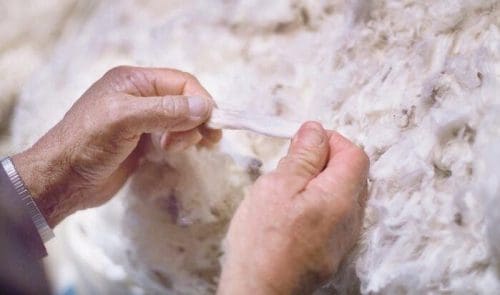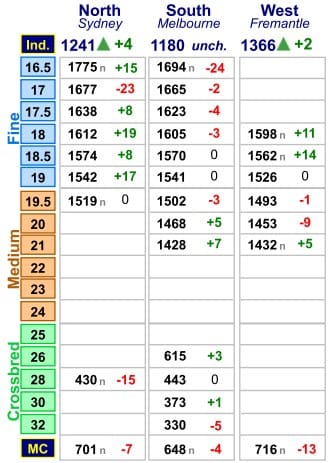 THE Australian Wool Exchange said wool prices experienced little change at auctions this week and brokers passed in 9.3 percent of the offering.
THE Australian Wool Exchange said wool prices experienced little change at auctions this week and brokers passed in 9.3 percent of the offering.
AWEX said the offering of 26,728 bales was just 891 fewer than last week.
“The Australian dollar compared to the US dollar went down US0.05 cents, hardly a currency movement influence the market.”
AWEX said the benchmark Eastern Market Indicator rose by the barest of margins – up one cent to 1204 cents/kg clean.
“When viewed in US dollar terms, the EMI was unchanged.”
AWEX said across all centres and all microns, the Merino and crossbred MPG movements ranged between being up 19 cents (18 microns in the north) to down 24 cents (16.5 microns in the south).
 “On the first day, the EMI rose by US 4 cents, the fourth selling day in a row where the EMI rose in US dollar terms.
“On the first day, the EMI rose by US 4 cents, the fourth selling day in a row where the EMI rose in US dollar terms.
“As the season draws to a close, there are plenty of positives in the market,” AWEX said.
“The EMI opened the season at 1129 cents/kg and is currently trading 75 cents higher, an increase of 6.6 percent,” AWEX said.
“In USD terms, the EMI opened at US750 cents, and the season to date 26-cent rise equates to an increase of 3.5pc.”
AWEX said another positive was the increase in the amount of Merino fleece carrying less than 1pc vegetable matter, a highly sought after type.
“After a steady decline last week, just 31.7pc of the offering was less than 1pc VM.
“This week’s figures increased by 7.7pc to 39.4pc.”
AWEX said this can be partly attributed to older wool grown when seasonal conditions were more favourable.
Largest Australian exporter leads buyers – AWI
Australian Wool Innovation trade consultant Scott Carmody said a rather rudimentary Australian wool auction series was the main outcome of this week’s action.
“A very uncomplicated auction environment coupled with an unusually sedate Australian dollar (AUD) to produce negligible alterations to established wool price quotations.
“The largest Australian exporter led buyers list week across the Merino combing wool sector, but also featured on carding and crossbred boards,” he said.
“China’s largest top maker provided the stiffest of competition, but price setting was mainly done by a few Chinese and Indian indents requiring better specifications and some direct to mill buying orders looking for the same quality.”
Mr Carmody said some notable prices were paid this week, notwithstanding the general unchanged nature of the market.
“These prices fetched around 10% premiums and almost predominantly for the highest accreditation sale lots or the best quality and properly prepared wools on offer.
“This was on wools testing from 14.4micron right through to 20micron, although quantity limited,” he said.
“Demand for traders from offshore was just good enough to hold the market in place, despite the concerningly low volumes on offer now.
“The bid prices being received by local exporters are increasingly skinny,” he said.
“Potential margins are being reported as almost zero to none/loss making, yet every opportunity to at least attempt to cover overheads is being sought in the very tough trading circumstances.
“The same economic circumstances are being felt right across the local industry here in Australia, with the obvious effect being placed upon wool growers’ production and incomes being lower despite the stability of pricing the past few years,” Mr Carmody said.
“The knock-on effect of the 10pc to 15pc loss of bales is also having impact on our wool selling brokers, the test house, logistic and ancillary wool companies.
“Competitive pricing to local supply chain partners is often the lure to show growth—i.e. increase client base, but with the inflationary squeeze on all parts of the macro economy, opportunities to reduce cost to existing and budding new customers in Australia are slim,” he said.
“Local wool business owners and managers are all having to look for operational costs for savings rather than forcing price rises onto an already cost pressured industry.”
Around 23,600 bales are being offered next week, with Fremantle not offering due to the usual low availability of shorn wool at this time of year.
Sources – AWEX, AWI.

HAVE YOUR SAY